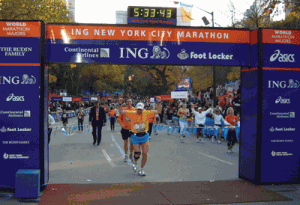This is Part One of a two-part post.
 The phone rings. You look at the number and don’t recognize it. You are desperately trying to finish a presentation your boss wants by tomorrow. You decide to let the call go to voicemail. At 5:35 p.m., you finally find time to listen to all 12 messages, but really are ready to go home.
The phone rings. You look at the number and don’t recognize it. You are desperately trying to finish a presentation your boss wants by tomorrow. You decide to let the call go to voicemail. At 5:35 p.m., you finally find time to listen to all 12 messages, but really are ready to go home.
Message 1 – “Hi, this is John Brown, and I am calling about a great sponsorship opportunity that will be a great fit for your brand….” You delete John Brown’s message without even thinking about returning the call. Why? The sponsorship was for a women’s tennis tour, and your brand’s target audience is teens. It’s not a fit.
You take a quick look at your desk’s in-box and all the mail the mailroom has dumped there. A big white envelope containing information about a concert tour sponsorship is buried on the bottom. You decide this deserves a deeper look, as it could be interesting given that your target audience and the concert tour audience are the same demographic. But after a cursory read, it goes into the garbage. Why? It’s January, and the concert tour starts in May. Your budget is done, and this won’t fit into your marketing plans that were completed six months ago.
To someone making those phone calls or sending the envelope, the above scenarios will seem very discouraging. The reality is that selling sponsorship and endorsement packages is really hard and the success rate low.
That said, the callers and senders could make their lives easier and improve their success rate if they would just stop throwing spaghetti at the wall and hoping a strand will stick. I can’t tell you how many times I have deleted those messages and thrown out that envelope. I probably got at least three a day as a promotion director for a variety of CPG companies with some very well-known brands. What I learned from talking to friends selling these sponsorships is that they just don’t understand what the brand teams are thinking and how to approach them. They think that if they keep calling, eventually the brand will talk to them. All they need to do is make the pitch and voila. These brand managers might listen if they pick up the phone, but it will be a short conversation if the property isn’t a fit for the product, etc.
So how can you end this frustrating back-and-forth for both sides? Based on my experiences, I have put together some key strategies for properties to make their sales efforts more productive. It takes more upfront research, but it increases your chances of being listened to and not ignored.
It’s All about the Target Audience
Every brand has a target audience, and that includes the brand’s psychographic as well as the demographic. The key to getting a brand interested is making sure your property and its target audience resonate with the brand’s target. If it doesn’t, that phone conversation will end before you even have a chance to describe your program. Sounds simple, doesn’t it? Unfortunately, too many salespeople tend to cast a very wide net. They have a list of all these big brands which the property thinks will have the dollars to spend against the sponsorship. They call the brands, thinking this property is a great fit for the brand because this is just the best property and will get the brand so much in return. What I wanted to say so often was, “Have you seen our advertising? Our target is moms with kids, and your property is a monster truck rally! Do you really think that’s a good fit?”
It’s ok to make a list of target brands, but make sure you do your research about those brands and then call. Look at their advertising, read their Facebook page, follow their Tweets. See what promotions they have run in the past and how they connect to their consumers. Determine if they have invested in sponsorship in the past, and don’t assume that because they sponsored tennis, they will sponsor tennis again. Are they sampling product and does your property have the vehicles this potential sponsor will want? You should only contact those brands which truly will be open to a property such as yours.
As a general rule of thumb, marketing plans are developed starting eight to 12 months prior to the new fiscal year. In some cases, especially with a new product launch, that window can go as far back as 18 months. There are exceptions and sometimes money does become available during the year, but it is unlikely those dollars will go to a sponsorship. When a property is looking for a sponsor for a program that is just six months away, it is going to be difficult for the brand to activate it. A strong strategic plan will have integrated components that fit a common idea or theme, and the chances that your property fits into an established theme are slim. The easy rule is to make sure that what you are selling is something that has at least a 12-month window before activation. That way, either the property can become part of the big idea OR the property becomes the cornerstone of a larger integrated plan. Also, these decisions are ones that companies take their time making and you generally can’t expect to get quick sign-ons. It just doesn’t work that way.
It Rarely is a Single Sport Platform
When I worked on a suncare brand, we sponsored beach volleyball, which was a great fit for the brand at the time. However, every property having to do with beach volleyball or another beach sport (beach tennis, anyone?) started contacting us. The pitch was the same – “We see you are sponsoring beach volleyball, and we have this volleyball tournament …” The reality was that we sponsored that specific tour for specific reasons and our overall platform was not beach sports or beach volleyball. The sponsorship was a means of promoting the efficacy of our brand, and it did not mean we were committed to volleyball or any other beach sport. If you look at brands that have large sports or entertainment sponsorship sponsorships (i.e., Amex, Bank of America, Nike), they usually have a broad platform because they are looking for ways to reach their target audience and one sport won’t reach everybody. The exception to that rule is a product designed specifically for one sport. While your property may be the perfect brand fit, you will also be competing with all the other properties in that sport. Alternately, a brand will sponsor one big tournament (US Open Tennis) or concert tour (Lady Gaga) because it is nationally reaching and part of an integrated program.
Local vs. National
Many companies have a different attitude toward local and charitable sponsorships in the community in which they have their headquarters or production facilities as opposed to big national sponsorships. Cost comparisons aside, companies like to give back to their local communities, whether financially or through the donation of time. If you are a local event without national reach, then focus on the companies nearest to you. I live in the same town as a national tea company. They are always sponsoring charity and local sporting events, but never a national program. For them, it is about giving back to their local community. I have also seen companies participate in the local Susan G. Komen Race for the Cure, but not participate at the national level. Again, take a look at what the company has done in the past to get a sense if they will even be open to your property.
It Has To Be More than Impressions and Media
Once upon a time, it was all about media impressions. Not anymore. In fact, I would argue there are more important considerations for a company, even though a company participating would see overall reach as very important. In evaluating a property, how much media supports it is less important to me than how I can leverage the property with my retail partners, how can it help me get product samples in the hands of consumers and how many of those going to the event are in my target audience. Many brands use sponsorships to get products in the hands of their consumers and will evaluate success based on the number of specific touchpoints the consumer has with the brand. So, does your property have sampling opportunities, is there a place for an interactive booth or vehicle and how will the consumer experience the brand other than seeing the logo? Don’t get me wrong, seeing the logo everywhere is great, but it is about connecting the experience and the brand to the consumer. Additionally, is there any way to conduct market research to help determine success? Can I link to a website? Can I develop an integrated program to support it? How much access will I have to performers or participants to visit retailers? All of this becomes important as I evaluate ROI. Media impressions are only part of that ROI equation, since it is hard to equate impressions to sales.
In Part Two I will address some specifics in the presentation itself and some direction in approaching the potential sponsor.
If you are a property looking for some help or guidance on how to develop effective sponsorship packages or a company needing help evaluating properties, please contact me at szweibaum@marketing-smith.com.

